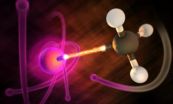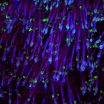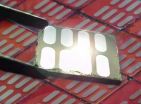(Press-News.org) Using ultra-short X-ray flashes, an international team of researchers watched electrons jumping between the fragments of exploding molecules. The study reveals up to what distance a charge transfer between the two molecular fragments can occur, marking the limit of the molecular regime. The technique used can show the dynamics of charge transfer in a wide range of molecular systems, as the scientists around Dr. Benjamin Erk and Dr. Daniel Rolles of DESY and Professor Artem Rudenko of Kansas State University report in the scientific journal Science. Such mechanisms play a role in numerous chemical processes, including photosynthesis.
"The charge transfer takes place at up to approximately ten times the normal bond length," says Erk, a DESY scientist working with the free-electron laser FLASH and at the Center for Free-Electron Laser Science (CFEL), a cooperation between DESY, the University of Hamburg and the Max Planck Society. "A central question posed is: when is a molecule a molecule," Rudenko says, explaining the motivation behind the study. "In this case then, up to what distance do the molecular components share electrons, at what distance does the charge transfer between the two molecular fragments break down? The critical distance we measured marks the transition from the molecular to the atomic regime."
For their study, the scientists shot an infrared laser at molecules of iodomethane (CH3I), made of iodine and a methyl group (CH3), to break the bond of the two partners. "With the help of ultra-short X-ray pulses, electrons were knocked from the inner shells of the iodine atoms, allowing us to then observe how the shared electrons of the disintegrating molecule were distributed between the two fragments," explains Rolles, who heads a junior research group at DESY. The researchers used what is currently the world's most powerful X-ray laser, LCLS, which is located at the SLAC National Accelerator Laboratory in California.
"During each step we delayed the X-ray pulse a bit more after the infrared laser pulse," says Erk. This delay ranged between a few femtoseconds and one picosecond, that is a trillionth of a second. "The later the X-ray pulse arrives, the farther apart the two molecular constituents move from each other." The researchers thus managed to obtain a series of snapshots in which the electron transfer can be observed at an ever-increasing distance between the molecular debris.
"The further apart the fragments move, the more the probability of the charge transfer decreases," explains Erk. "We were able to detect electrons jumping between the two fragments up to a distance of about 20 Ångström." The bond length of iodomethane is only about 2 Ångström, or 0.2 nanometres (millionths of a millimetre).
"Our results are important for a variety of systems," stresses Rudenko. "For instance, in astrophysics X-rays produced by charge transfer processes have been observed. Such mechanisms play an important role in numerous chemical processes, for example, in photosynthesis or in solar cells. And during their research, scientists who study biomolecules using X-rays struggle with radiation damage to their samples. Here, too, the processes we studied play an important role."
These first results also provide a bridge between the study of electron transfer between single atoms and the analysis of the charge flow in larger systems such as those that often occur in biology and chemistry. Further investigations will help to understand the observed process of charge transfer in detail.
INFORMATION:
SLAC National Accelerator Laboratory is a multi-program laboratory exploring frontier questions in photon science, astrophysics, particle physics and accelerator research. Located in Menlo Park, California, SLAC is operated by Stanford University for the U.S. Department of Energy Office of Science. SLAC's LCLS is the world's most powerful X-ray free-electron laser. Its highly focused beam shines a billion times brighter than previous X-ray sources to shed light on fundamental processes of chemistry, materials and energy science, technology and life itself.
Deutsches Elektronen-Synchrotron DESY is the leading German accelerator centre and one of the leading in the world. DESY is a member of the Helmholtz Association and receives its funding from the German Federal Ministry of Education and Research (BMBF) (90 per cent) and the German federal states of Hamburg and Brandenburg (10 per cent). At its locations in Hamburg and Zeuthen near Berlin, DESY develops, builds and operates large particle accelerators, and uses them to investigate the structure of matter. DESY's combination of photon science and particle physics is unique in Europe.
Reference
"Imaging charge transfer in iodomethane upon x-ray photoabsorption"; Benjamin Erk, Artem Rudenko et al.; Science, 2014; DOI: 10.1126/science.1253607
When is a molecule a molecule?
Scientists watch fast electron jumps in exploding molecules
2014-07-17
ELSE PRESS RELEASES FROM THIS DATE:
Pitt-led study suggests cystic fibrosis is 2 diseases, 1 doesn't affect lungs
2014-07-17
PITTSBURGH, July 17, 2014 – Cystic fibrosis (CF) could be considered two diseases, one that affects multiple organs including the lungs, and one that doesn't affect the lungs at all, according to a multicenter team led by researchers at the University of Pittsburgh School of Medicine. The research, published online today in PLOS Genetics, showed that nine variants in the gene associated with cystic fibrosis can lead to pancreatitis, sinusitis and male infertility, but leave the lungs unharmed.
People with CF inherit from each parent a severely mutated copy of a gene ...
Scientists find protein-building enzymes have metamorphosed & evolved new functions
2014-07-17
LA JOLLA, CA AND JUPITER, FL—Scientists at The Scripps Research Institute (TSRI) and Hong Kong University of Science and Technology (HKUST) and their collaborators have found that ancient enzymes, known for their fundamental role in translating genetic information into proteins, evolved myriad other functions in humans. The surprising discovery highlights an intriguing oddity of protein evolution as well as a potentially valuable new class of therapeutic proteins and therapeutic targets.
"These new protein variants represent a previously unrecognized layer of biology—the ...
A new stable and cost-cutting type of perovskite solar cell
2014-07-17
Perovskite solar cells show tremendous promise in propelling solar power into the marketplace. The cells use a hole-transportation layer, which promotes the efficient movement of electrical current after exposure to sunlight. However, manufacturing the hole-transportation organic materials is very costly and lack long term stability. Publishing in Science, a team of scientists in China, led by Professor Hongwei Han in cooperation with Professor Michael Grätzel at EPFL, have developed a perovskite solar cell that does not use a hole-transporting layer, with 12.8% conversion ...
Scientists complete chromosome-based draft of the wheat genome
2014-07-17
MANHATTAN, Kansas — Several Kansas State University researchers were essential in helping scientists assemble a draft of a genetic blueprint of bread wheat, also known as common wheat. The food plant is grown on more than 531 million acres around the world and produces nearly 700 million tons of food each year.
The International Wheat Genome Sequencing Consortium, which also includes faculty at Kansas State University, recently published a chromosome-based draft sequence of wheat's genetic code, which is called a genome. "A chromosome-based draft sequence of the hexaploid ...
Ultrafast X-ray laser sheds new light on fundamental ultrafast dynamics
2014-07-17
MANHATTAN, Kansas — Ultrafast X-ray laser research led by Kansas State University has provided scientists with a snapshot of a fundamental molecular phenomenon. The finding sheds new light on microscopic electron motion in molecules.
Artem Rudenko, assistant professor of physics and a member of the university's James R. Macdonald Laboratory; Daniel Rolles, currently a junior research group leader at Deutsches Elektronen-Synchrotron in Hamburg, Germany, who will be joining the university's physics department in January 2015; and an international group of collaborators ...
No evidence that California cellphone ban decreased accidents, says Colarado University Boulder researcher
2014-07-17
In a recent study, a researcher at the University of Colorado Boulder found no evidence that a California ban on using hand-held cellphones while driving decreased the number of traffic accidents in the state in the first six months following the ban.
The findings, published in the journal Transportation Research Part A: Policy and Practice, are surprising given prior research that suggests driving while using a cellphone is risky. For example, past laboratory studies have shown that people who talk on a cellphone while using driving simulators are as impaired as people ...
Peering into giant planets from in and out of this world
2014-07-17
Lawrence Livermore scientists for the first time have experimentally re-created the conditions that exist deep inside giant planets, such as Jupiter, Uranus and many of the planets recently discovered outside our solar system.
Researchers can now re-create and accurately measure material properties that control how these planets evolve over time, information essential for understanding how these massive objects form. This study focused on carbon, the fourth most abundant element in the cosmos (after hydrogen, helium and oxygen), which has an important role in many types ...
Help wanted: Principals who love change
2014-07-17
DALLAS (SMU) – Training principals for new roles is key to U.S. Department of Education school reforms, according to a new report by SMU researchers. But insufficient training and support for principals to meet the new expectations is leading to a leadership crisis. Twenty percent of newly minted principals leave the profession after two years and seasoned professionals are opting for early retirement.
Education researchers Lee Alvoid and Watt Lesley Black Jr. examine school districts at the forefront of supporting and training effective principals in their report "The ...
CNIO researchers discover a gene that links stem cells, aging and cancer
2014-07-17
An organism is healthy thanks to a good maintenance system: the normal functioning of organs and environmental exposure cause damage to tissues, which need to be continuously repaired. This process is not yet well understood, but it is known that stem cells in the organs play a key role, and that when repair fails, the organism ages more quickly. Researchers from the Spanish National Cancer Research Centre (CNIO) have "discovered one of the key genes that make up the maintenance mechanism for tissues" says Miguel Foronda, the first author of the manuscript.
The study ...
First ab initio method for characterizing hot carriers
2014-07-17
One of the major road blocks to the design and development of new, more efficient solar cells may have been cleared. Researchers with the Lawrence Berkeley National Laboratory (Berkeley Lab) have developed the first ab initio method – meaning a theoretical model free of adjustable or empirical parameters – for characterizing the properties of "hot carriers" in semiconductors. Hot carriers are electrical charge carriers - electrons and holes – with significantly higher energy than charge carriers at thermal equilibrium.
"Hot carrier thermalization is a major source of ...
LAST 30 PRESS RELEASES:
Climate policies can backfire by eroding “green” values, study finds
Too much screen time too soon? A*STAR study links infant screen exposure to brain changes and teen anxiety
Global psychiatry mourns Professor Dan Stein, visionary who transformed mental health science across Africa and beyond
KIST develops eco-friendly palladium recovery technology to safeguard resource security
Statins significantly reduce mortality risk for adults with diabetes, regardless of cardiovascular risk
Brain immune cells may drive more damage in females than males with Alzheimer’s
Evidence-based recommendations empower clinicians to manage epilepsy in pregnancy
Fungus turns bark beetles’ defenses against them
There are new antivirals being tested for herpesviruses. Scientists now know how they work
CDI scientist, colleagues author review of global burden of fungus Candida auris
How does stroke influence speech comprehension?
B cells transiently unlock their plasticity, risking lymphoma development
Advanced AI dodel predicts spoken language outcomes in deaf children after cochlear implants
Multimodal imaging-based cerebral blood flow prediction model development in simulated microgravity
Accelerated streaming subgraph matching framework is faster, more robust, and scalable
Gestational diabetes rose every year in the US since 2016
OHSU researchers find breast cancer drug boosts leukemia treatment
Fear and medical misinformation regarding risk of progression or recurrence among patients with breast cancer
Glucagonlike peptide-1 receptor agonists and asthma risk in adolescents with obesity
Reviving dormant immunity: Millimeter waves reprogram the immunosuppressive microenvironment to potentiate immunotherapy without obvious side effects
Safety decision-making for autonomous vehicles integrating passenger physiological states by fNIRS
Fires could emit more air pollution than previously estimated
A new way to map how cells choose their fate
Numbers in our sights affect how we perceive space
SIMJ announces global collaborative book project in commemoration of its 75th anniversary
Air pollution exposure and birth weight
Obstructive sleep apnea risk and mental health conditions among older adults
How talking slows eye movements behind the wheel
The Ceramic Society of Japan’s Oxoate Ceramics Research Association launches new international book project
Heart-brain connection: international study reveals the role of the vagus nerve in keeping the heart young
[Press-News.org] When is a molecule a molecule?Scientists watch fast electron jumps in exploding molecules



